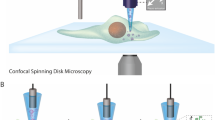Abstract
HIBBS1 has demonstrated the existence of intercellular canaliculi in human eccrine sweat glands by electron microscopy and found them to be situated in the coiled secretory portion of the glands only. He was unable to recognize intracellular canaliculi, however. These intercellular canaliculi can be seen from his illustrations to be lined by a plasma membrane which shows many micro-villi projecting into the lumen. This lumen contains a moderately homogeneous matrix of low density and several indistinct granular profiles, possibly in the nature of a secretion.
This is a preview of subscription content, access via your institution
Access options
Subscribe to this journal
Receive 51 print issues and online access
$199.00 per year
only $3.90 per issue
Buy this article
- Purchase on Springer Link
- Instant access to full article PDF
Prices may be subject to local taxes which are calculated during checkout
Similar content being viewed by others
References
Hibbs, R. G., Amer. J. Anat., 103, 201 (1958).
Author information
Authors and Affiliations
Rights and permissions
About this article
Cite this article
SCOTT, T. Intracellular Canals in Human Sweat Glands. Nature 188, 158–159 (1960). https://doi.org/10.1038/188158a0
Issue Date:
DOI: https://doi.org/10.1038/188158a0
Comments
By submitting a comment you agree to abide by our Terms and Community Guidelines. If you find something abusive or that does not comply with our terms or guidelines please flag it as inappropriate.



